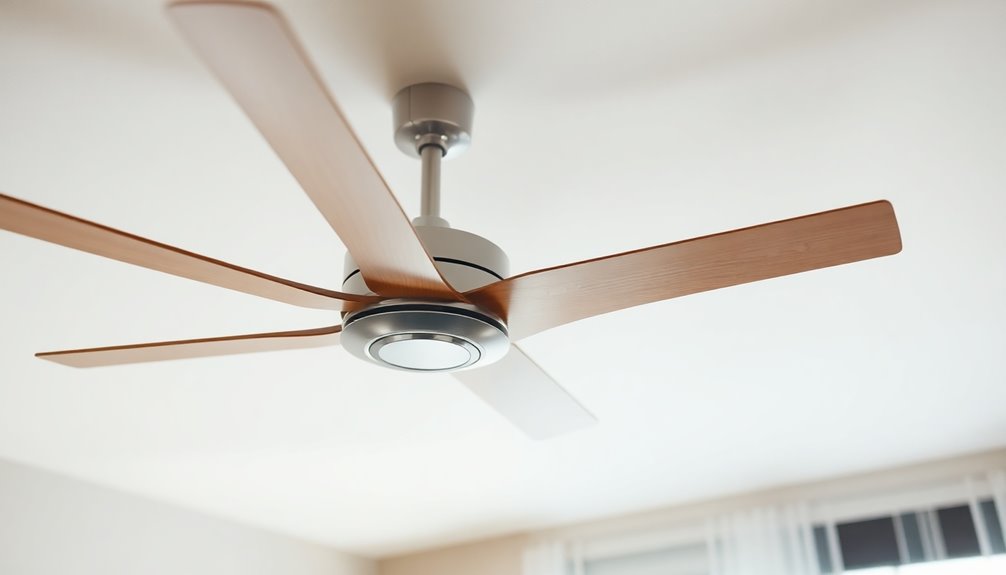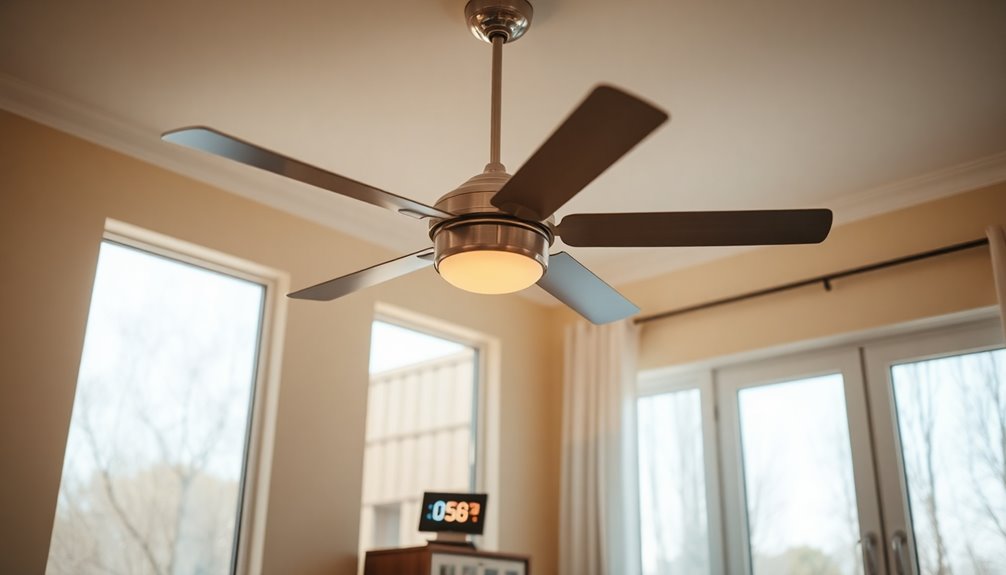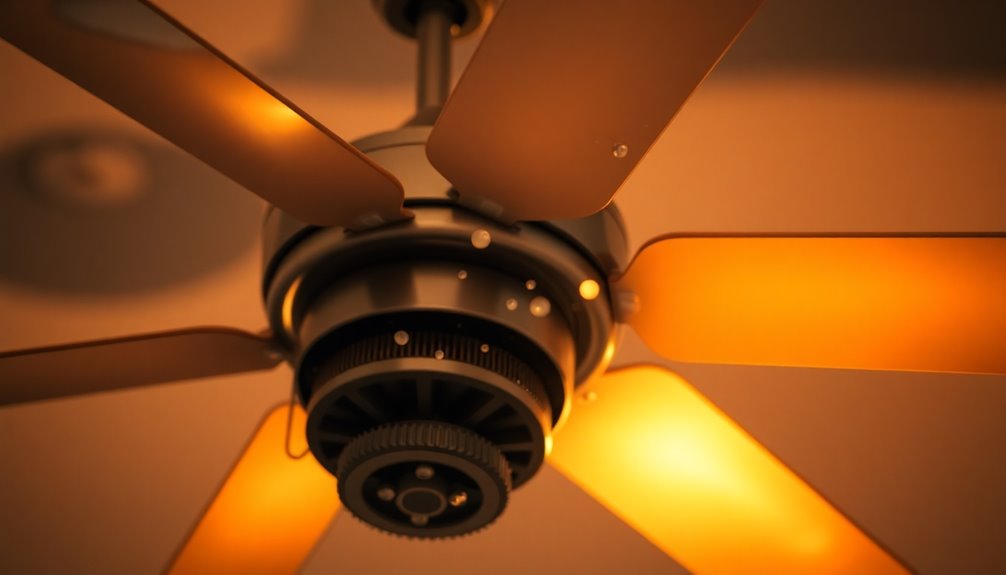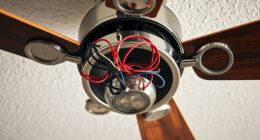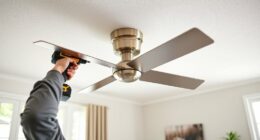You'll typically find the switch on a ceiling fan located on the motor housing, either on the side or bottom. It might be a small toggle button or part of a pull chain. If your fan's remote control features a direction option, you can adjust it without direct access. For smart fans, you can change the direction using a mobile app or voice command. Always make sure to turn off the fan before locating or changing the switch for safety. Stick around, and you'll discover the best ways to maximize your ceiling fan's efficiency for year-round comfort.
Key Takeaways
- The switch is usually located on the motor housing, either on the side or bottom of the ceiling fan.
- For pull chain models, a small toggle button is typically found near the pull chain itself.
- Remote-controlled fans have directional settings accessible via the remote, but ensure the fan is off before adjusting.
- Smart ceiling fans allow direction changes through a mobile app or voice command after powering down the fan.
- Always ensure the fan is turned off before locating or changing the direction switch for safety.
Location of the Ceiling Fan Switch

The switch for changing the direction of your ceiling fan is usually found on the motor housing, often positioned on the side or bottom of the unit.
When you check this location, you'll likely find a small toggle button or a pull chain that activates the ceiling fan switch to reverse the blade direction. If you've got a pull chain fan, just give the chain a tug to change the direction easily.
For those with remote control options, you can adjust the fan's direction without physically accessing the switch. This feature adds convenience, especially if your fan is mounted high.
Additionally, smart ceiling fans take it up a notch by allowing you to change the direction through a mobile app or voice command.
No matter what type of fan you have, it's essential to prioritize safety. Always turn off the ceiling fan before attempting to locate or change the direction switch.
This guarantees you won't accidentally get hurt while adjusting your fan. Now that you know where to look, you can enjoy improved airflow and comfort in your space!
Types of Ceiling Fan Switches

When it comes to controlling your ceiling fan, you've got a couple of options.
You can use a manual direction switch, often found on the fan body, or opt for the convenience of remote control options.
Both methods allow you to easily change the fan's direction to suit your needs.
Manual Direction Switch
Understanding the manual direction switch on a ceiling fan is essential for maximizing comfort and airflow in your space. This switch is typically located on the fan's motor housing, often near the pull chain. By changing the direction of the blades, you can enhance your room's airflow according to the season.
When the fan rotates clockwise, it pushes warm air down, making it ideal for winter. Conversely, when set to counterclockwise, it creates a cooling breeze, perfect for summer.
Before you adjust the manual direction switch, remember to turn off the fan to guarantee safety.
Here's a quick reference table to help you understand the effects of changing the direction:
| Direction | Effect on Airflow |
|---|---|
| Clockwise | Warms the room by pushing air down |
| Counterclockwise | Cools the room by circulating air upward |
With many modern ceiling fans, you might find a toggle switch for easy adjustments, or even a button on the remote control. Knowing how to utilize the manual direction switch will help you create a comfortable environment year-round.
Remote Control Options
In today's world, remote control options for ceiling fans have become a popular choice for convenience and ease of use. These controls not only simplify operation but also enhance the overall experience. Here are some key features you might enjoy:
- Adjust fan speed effortlessly
- Change your ceiling fan's direction with a dedicated button
- Utilize smart ceiling fans for app-based control
- Set timers for energy-efficient operation
- Control light settings remotely
With remote control fans, you can easily manage fan speed and airflow without ever leaving your seat. If you want to change your ceiling fan's direction, simply press a button on the remote, allowing for quick adjustments between clockwise and counterclockwise settings.
Many smart ceiling fans take this a step further, letting you control everything right from your mobile device. For added convenience, look for models with built-in timer functions that can automatically turn off the fan after a set period, making them energy efficient.
Always verify the remote is properly paired with the fan; check the manufacturer's instructions to avoid any operational issues. Enjoy the effortless comfort that remote control options bring to your space!
How to Change Fan Direction

To change your ceiling fan's direction, first locate the direction switch, usually found on the motor housing or accessible via a pull chain.
Once you've identified it, confirm the fan is off before adjusting for safety.
Finally, turn the fan back on and verify its rotation to guarantee you've set it correctly for the season.
Locating the Direction Switch
Finding the direction switch on your ceiling fan is a straightforward task that can greatly enhance your comfort. Knowing how to locate this switch will allow you to change the direction of the ceiling fan blades efficiently. Here are some tips to help you:
- Check the fan motor housing for a visible toggle or slide switch.
- Look for a pull chain that may also have the direction switch integrated.
- If you have a fan remote, the direction option is often included there.
- For smart ceiling fans, use your mobile app for easy adjustments.
- Always turn off the fan before you start searching for the direction switch to guarantee safety.
Once you've located the direction switch, you can easily change direction to suit the season. During summer, you want the ceiling fan blades to spin counterclockwise to create a cool breeze.
In winter, switch it to clockwise to circulate warm air. Remember, whether you're using a physical switch or a fan remote, always prioritize safety by turning off the fan before making any adjustments. This way, you'll enjoy a comfortable environment all year round!
Changing Direction Safely
Changing the direction of your ceiling fan is essential for maintaining comfort in your home throughout the year. To change the direction safely, always verify the fan is turned off and the blades have completely stopped. This precaution helps prevent any accidents while you're adjusting the fan's settings.
If your fan has a pull chain, locate the reversing switch, which is typically a small toggle or slide switch on the fan body. For remote-controlled fans, you'll need to pair the remote, turn off the fan, and then press and hold the fan button until the light blinks to switch directions.
Smart ceiling fans can be adjusted using the SIMPLEconnect app or through voice commands, but don't forget to power off the fan first.
It's a good idea to change the fan direction at the start of each season. In the summer, set the fan to spin counterclockwise to create a cooling breeze. In the winter, switch it to clockwise to circulate warm air efficiently.
This simple change not only enhances your comfort but also helps optimize energy use throughout the year.
Verifying Fan Rotation
After adjusting the direction of your ceiling fan, it's important to verify that it's rotating correctly. This step guarantees that the changes you made are effective and that you can enjoy peak comfort. Here's how you can do it:
- Turn off the fan before making adjustments.
- Locate the reversing switch on the fan's motor housing.
- For remote-controlled fans, use the designated button for direction change.
- Turn the fan on at a low speed.
- Observe the blade's rotation to confirm if it's moving clockwise or counterclockwise.
Once you've made the necessary adjustments, it's vital to verify the fan's rotation.
Start by turning the fan on at a low speed. This allows you to see if the blades are moving in the desired ceiling fan direction. If you've set it to blow air downwards for summer, it should spin counterclockwise. For winter, the fan should rotate clockwise to circulate warm air.
If the direction isn't as expected, simply turn the fan off, switch it back, and repeat. With these steps, you'll guarantee your ceiling fan is working just right!
Seasonal Fan Direction Guidelines

Many homeowners overlook the importance of adjusting their ceiling fans with the changing seasons. To maximize comfort and improve energy efficiency, you need to change the ceiling fans direction at least twice a year.
In summer, set your fan to rotate counterclockwise. This fan direction in summer creates a cooling downdraft, making the room feel around 10 degrees cooler.
As fall approaches, switch to clockwise rotation at a low speed. This change helps create an updraft, redistributing warm air that collects near the ceiling. By doing this, you can reduce your heating costs by up to 15%.
A great way to remember these seasonal adjustments is to align them with Daylight Saving Time—adjust your fan when you change your clocks.
Regularly changing a ceiling fan's direction enhances air circulation, maintaining a stable indoor temperature throughout the year.
Benefits of Proper Fan Direction

Adjusting your ceiling fan's direction according to the seasons offers impressive benefits that go beyond mere comfort.
By guaranteeing proper fan direction, you can create a more comfortable home while saving energy.
Here's how you can maximize your fan usage:
- Stay Cool in Summer: Use the ceiling fan counterclockwise to create a cooling downdraft, making rooms feel about 10 degrees cooler.
- Warmth in Winter: Switch to ceiling fan clockwise to redistribute warm air, potentially reducing heating costs by up to 15%.
- Energy Savings: Adjust your thermostat up to 4°F higher in summer without sacrificing comfort, leading to significant energy savings.
- Efficient Pairing: Pairing your fan with an ENERGY STAR-rated AC unit can save an additional 8% on energy costs.
- Year-Round Comfort: Regularly changing the fan direction guarantees peak airflow, enhancing comfort and energy efficiency throughout the year.
- Safety Considerations: Always ensure that the ceiling fan's installation complies with local fire safety regulations to avoid potential hazards.
Troubleshooting Common Issues

Ceiling fans can sometimes be a source of frustration when they don't operate as expected. If your ceiling fan isn't changing direction, start by locating the direction switch. For fans with pull chains, this switch is usually a small toggle on the fan motor housing.
If you've got a remote control, check if there's a directional setting on it, but make certain the fan is turned off before you try to change direction.
For smart ceiling fans, you can often adjust the blades' direction through a mobile app, but again, make certain the fan is powered off first.
If you've toggled the switch or used the remote, and the fan blades still won't change direction, it could indicate a problem with the fan motor or the switch itself.
In such cases, troubleshooting is essential. Check connections and make certain power is flowing correctly.
If the issue persists, it might be time to consult a professional. Addressing these common issues will help you enjoy the benefits of your ceiling fan without the headaches.
Enhancing Energy Efficiency

Using a ceiling fan can greatly boost your home's energy efficiency and comfort. By properly utilizing a ceiling fan, you can reduce cooling costs and make your home more comfortable year-round. Here are some key benefits:
- Raise thermostat settings by up to 4°F without sacrificing comfort
- Reduce cooling costs by up to 30% when paired with air conditioning
- Achieve utility bill reductions of 15% in winter by redistributing warm air
- Consume only 50 watts compared to typical AC units using 3,500 watts
- Pair with ENERGY STAR-rated AC units for an extra 8% energy savings
To maximize these benefits, make sure your ceiling fan is set to rotate counterclockwise during the summer. This direction pushes cooler air down, providing an invigorating breeze.
In winter, switch the fan to clockwise to circulate warm air trapped near the ceiling, enhancing energy efficiency. Additionally, using a ceiling fan in conjunction with energy-efficient heat pumps can further optimize your home's climate control and reduce overall energy consumption.
By implementing these simple strategies, you can markedly lower your utility bill while keeping your home more comfortable throughout the year.
Embrace the power of your ceiling fan and enjoy the energy savings!
Frequently Asked Questions
Does My Ceiling Fan Have a Switch?
To find out if your ceiling fan has a switch, check the fan's motor housing or body. Many modern fans include a reversing switch there.
You might also look for it on the pull chain or remote control if your fan has one. If it's a smart fan, you can use a mobile app or voice command to change the settings.
Always turn off the fan before searching for the switch to guarantee safety.
Where Is the Toggle Switch on a Ceiling Fan?
Isn't it ironic how something that spins so effortlessly can hide its secrets?
When you're trying to find the toggle switch on your ceiling fan, look near the motor housing. It's usually close to the pull chain or remote receiver.
If you've got a modern fan, you might just change the direction with your remote.
Just remember to turn off the fan before you start your little treasure hunt for that elusive switch!
How Do I Switch My Ceiling Fan?
To switch your ceiling fan, first, make sure it's turned off for safety.
Locate the direction switch, usually found on the motor housing or as part of the pull chain. If your fan has a remote or smart app, you can change the direction with just a button press.
Once you've toggled the switch, turn the fan back on at a low speed to check that the blades are spinning in the correct direction.
Where Is the Switch for the Fan?
Oh sure, finding the switch for your fan is like hunting for a unicorn, right?
But don't worry, it's simpler than you think! Typically, you'll find the switch on the motor housing, often near the pull chain or the remote control receiver.
If it's a pull chain model, check the underside closely. For remote fans, just look for those magical directional arrows.
Easy-peasy! You'll be a fan-switching expert in no time!
Conclusion
To sum up, knowing where the switch on your ceiling fan is can really enhance your comfort and energy efficiency. Did you know that using ceiling fans can help you save up to 40% on your cooling costs during the summer? By adjusting the fan direction seasonally and keeping it in good shape, you not only create a more pleasant environment but also cut down on energy bills. So, take a moment to check your fan settings today!
